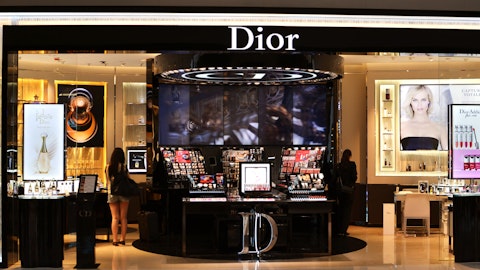Unidentified Analyst: Yes. I think before you stated that it should be above the 40% level. Is that still the ambition?
Sean MacDonald: Correct. That is absolutely correct. We should not be below 40%. This is a one-off quarter where we had some write-offs.
Unidentified Analyst: Yes. Okay. And then moving to the working capital situation. So the inventory levels remain pretty high at your end. What is the main reason for that? And then on the other hand, the accounts payable, they dropped quite a bit in Q4. What is the reason for that?
Sean MacDonald: Yes. So inventory is pretty stable. Obviously now we have plenty of inventory at Leatt USA that we’re going to be selling into the market over the next few periods. And because we had a constrained selling environment with inventory that we had already on the water coming into stock for new product, we’ve now got that inventory in stock, and we can now sell it out. So we’re now busy selling through that inventory. Of course, it’s also a factor of the fact that we have added a lot of new products we’ve got a lot of that inventory is brand-new stock that we are now going to be selling. We’ve increased our SKU count significantly. If you look at the model year ’23 compared to ’22, we’ve got a lot more SKUs now because we’ve got much wider apparel line, we’ve got more helmets, we’ve got — we head-to-toe on the MTB side.
We’ve got more shoes. We’ve got more boots. So a big reason for the increase in inventory is just the fact that we’ve got more product to sell, which is obviously positive. As I said, we had a look at our inventory. Our inventory is now at a very prudent level in terms of valuation. I think we took a deep look at inventory during Q4. So this is all fresh stock that we have available to be able to sell into the market. So — of course, we have the ability to look at our reordering levels in order to make sure that our inventory does not get out of control. And I think over time now, you should start seeing inventory dropping as we move into the next few quarters as we sell the inventory that we have. So that’s inventory. In terms of accounts payable, we had a decrease in accounts payable, and that is just a function of the fact that because we’ve got inventory to sell, we are not placing orders on the factories that are as large as what they were last year when we had a full channel that we needed to supply to Leatt USA and Leatt South Africa.
So our accounts payable would then be lower.
Unidentified Analyst: Yes. Okay. And then in terms of destocking effects, what is your best guess in terms of quarters that you need to digest the trends?
Sean MacDonald: To adjust the trend, I think it’s going to take a few quarters. I mean it depends very much, it’s very different geographically. And I have different geographical areas and not all areas react over the same amount of time. I mean the industry has — most people that I speak to in the industry have said that it’s going to take several quarters. They don’t know whether this is 8 months or 12 months. But we are certainly looking forward to — we’re going to carry on pushing. We’re developing new products. We’ve got some great products in the pipeline, and we’re certainly looking forward to being able to return to the kind of stocking levels that we’ve been able to achieve in previous quarters. So this is going to take a few quarters to be digested.
It is an industry-wide phenomenon. I think some of our peers that have reported would have reported some other things. So this is across brands. It is very encouraging for us on Leatt side to hear from a lot of our dealers and distributors that the Leatt brand is still pretty strong. But of course, they have limited amount of inventory that they can purchase in terms of their working capital. So that all needs to filter through. It is going to take some time, but we do feel that we will return to solid growth as soon as possible.
Unidentified Analyst: Yes. Okay. Okay. And then the final question I have is on your market share. So in 2022, the sales was up 5%. But how would you split up the sales flows coming from market share gains versus the market decline? Any views on that?
Sean MacDonald: I mean it’s quite difficult to quantify that with precision. However, what I would say is that looking at some of the industry, the commentary that I see from the industry, there are many categories where we are still in our infancy 3% to 4% to 5% kind of market share. We’ve seen — we think that we’ve had solid market share growth over the last 2 years because of the fact that we have had the ability to supply on a consistent basis and some of our peers have not been able to do so. So we’ve had pretty solid market share growth. I would say the 5% to 6% area is probably where we’re at. I think there’s a large portion, it could be 20% of our sales over the last 24 months that have come from really aggressively being in a position to get more shelf space in dealers, online and brick-and-mortar, which is obviously taking some market share from our competitors.
And I think that bodes well for the future because we still have a good position in the dealerships and at the distributors, they have a certain amount of inventory of Leatt stock, but they do feel that they will sell that out within a reasonable amount of time.
Operator: Our next question is from the line of , Private Investor.





